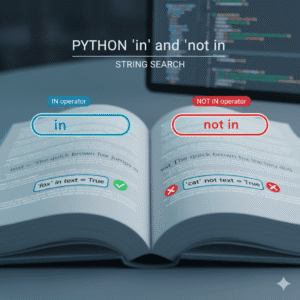Have you ever fallen in love with Python’s lambda functions for their simplicity, only to hit a frustrating wall? You’re trying to write a compact function that finds the smaller of two numbers, but your if statement inside the lambda causes a syntax error. What’s going on?
The problem is a key limitation of lambdas: they are designed for simple, single-expression operations. You can’t use multi-line statements like if-else blocks inside them. So, how do you perform conditional logic in a single line? The answer lies in a powerful, compact tool: the Python ternary operator.
In this guide, you’ll learn exactly what the ternary operator is, how its unique syntax works, and how to use it to write clean, efficient conditional expressions, especially within lambda functions. By the end, you’ll have a new tool to make your code more Pythonic and concise.
What is the Ternary Operator?
Let’s start with a simple analogy. Imagine you’re making a decision:
- The Long Way: “If it’s raining, then I will take an umbrella. Otherwise, I will wear sunglasses.”
- The Short Way: “I will take an umbrella if it’s raining, otherwise sunglasses.”
The ternary operator lets you write the “short way” in your code. It’s a conditional expression that evaluates one of two values based on whether a condition is True or False. The best part? It all happens in a single line.
The official term is “conditional expression,” but it’s universally known as the ternary operator because it operates on three components (more on that in a second). It’s the only operator in Python that takes three operands.
Why Can’t We Use if Statements in Lambdas?
As the video caption highlights, this is a common stumbling block. Lambda functions are meant for simplicity and are restricted to a single expression.
Try to put a multi-line if statement inside one, and Python will throw an error.
# This will FAIL because 'if' is a statement, not an expression.
minimum = lambda x, y: if x < y: return x else: return y
# SyntaxError: invalid syntaxEven trying to separate statements with a semicolon doesn’t work as intended within the lambda’s single-expression context.
# This doesn't work as you might hope.
x = lambda a: (print("hello"); a + 1) # Syntax ErrorThe ternary operator solves this by being a single, compact expression that fits perfectly within a lambda’s structure.
How to Use the Python Ternary Operator
The syntax might look unusual at first, but it’s logical once you break it down.
Here is the basic structure:
[value_if_true] if [condition] else [value_if_false]
Let’s dissect it:
- First Operand (
[value_if_true]): This is the output if the condition evaluates toTrue. - Second Operand (
[condition]): This is the boolean expression that is tested. - Third Operand (
[value_if_false]): This is the output if the condition evaluates toFalse.
The operator flows in a way that reads almost like English: “Use this value if this condition is true, else use this other value.”
Basic Example: Finding the Maximum
Let’s see it in action outside of a lambda first.
# Using a traditional if-else block
a, b = 10, 20
if a > b:
max_value = a
else:
max_value = b
print(max_value) # Output: 20
# The same logic with the ternary operator
max_value = a if a > b else b
print(max_value) # Output: 20The ternary version is much more concise and can be written directly on a single assignment line.
Supercharging Lambdas with the Ternary Operator
Now, let’s solve the problem from the video caption. We want to create a lambda function that returns the minimum of two numbers. The ternary operator is the perfect fit.
Here’s how we do it:
# Creating a lambda to find the minimum value
minimum = lambda x, y: x if x < y else y
# Let's test it!
print(minimum(10, 90)) # Output: 10
print(minimum(50, 30)) # Output: 30It works perfectly! The lambda minimum takes two arguments, x and y. It then evaluates the condition x < y.
- If
xis less thany, the expression evaluates tox. - If the condition is false (meaning
xis greater than or equal toy), the expression evaluates toy.
This single, powerful line replaces what would have required a multi-line function definition.
Another Practical Example: Simple Input Validation
Imagine you’re processing a score and want to ensure it’s non-negative.
# Using a ternary to ensure a non-negative value
score = -5
processed_score = score if score >= 0 else 0
print(processed_score) # Output: 0
score = 42
processed_score = score if score >= 0 else 0
print(processed_score) # Output: 42You could even wrap this in a lambda for quick use, perhaps in a map function.
# A lambda for quick validation in a list
scores = [10, -5, 20, -1, 15]
validator = lambda s: s if s >= 0 else 0
valid_scores = list(map(validator, scores))
print(valid_scores) # Output: [10, 0, 20, 0, 15]Ready to Go from Basics to Pro?
You’ve just unlocked a key technique for writing professional, readable Python code. Mastering these fundamentals is what separates beginners from proficient developers. If you enjoyed this deep dive into a specific concept, imagine what you could achieve with a structured learning path that covers everything from core syntax to advanced libraries and real-world projects.
Our comprehensive course is designed to take you step-by-step on that journey, with expert guidance and practical exercises that build true mastery.
If you’re serious about mastering Python, check out our pre-recorded python comprehensive video course.
Conclusion
The Python ternary operator (x if condition else y) is an indispensable tool for writing clean and concise conditional expressions. It elegantly solves the limitation of using conditionals inside lambda functions, allowing you to pack simple if-else logic into a single line. Remember, it’s all about choosing the right value based on a condition without the verbosity of a full block.
Keep practicing by incorporating the ternary operator into your lambdas and other assignments. Before long, you’ll be using it instinctively to write more Pythonic code.
Common Questions About the Ternary Operator
Can I nest ternary operators in Python?
Yes, but use caution as it can quickly become unreadable. For example, 'a' if x > y else 'b' if x < y else 'c' finds if x is greater, lesser, or equal to y. For complex conditional logic, a traditional if-elif-else block is often clearer.
Is the ternary operator faster than an if-else statement?
The performance difference is negligible. The primary benefit of the ternary operator is not speed, but improved code readability and conciseness for simple conditions.
What happens if I forget the else part?
You will get a SyntaxError. The ternary operator is a complete conditional expression and must always specify what to return in both the True and False cases.















